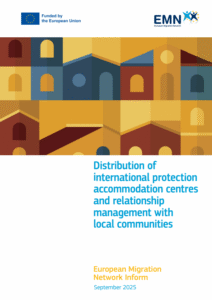EMN inform examines international protection accommodation centres and local engagement
29.09.2025The EMN’s latest inform compares how 23 EMN Member Countries and Serbia distribute international protection applicants and accommodation centres, work with local communities, and address integration challenges. The inform analyses two distinct types of distribution: the distribution of international protection applicants and the distribution of accommodation centres. Fourteen EMN Member Countries and Serbia distribute international protection applicants according to defined criteria, while 17 EMN Member Countries and Serbia distribute accommodation centres within their territory. Criteria include regional demographics, infrastructure, proximity to services, and individual needs assessments such as health conditions, family status, and vulnerability.
Only five countries have formal communication plans to support the opening of new centres. Others rely on guidance or case-by-case outreach. Despite this, most responding countries engage with local authorities and elected representatives before or upon opening new accommodation centres. Sixteen also engage directly with local communities during this process.
In Belgium, for example, the national reception agency distributes flyers to local residents, holds information sessions with stakeholders, and appoints contact persons ahead of the centre’s opening. In Ireland, local outreach is structured around community integration forums, while the Netherlands has issued national guidelines to support municipal engagement and manage public information.
The inform highlights that most responding countries face challenges in engaging with local stakeholders, particularly in areas with limited prior experience of multicultural communities. Common issues include resistance from local residents and elected officials, lack of political will, and political tensions. A smaller number of countries reported delays in communication and complex coordination mechanisms. These challenges can affect not only the opening of accommodation centres but also their successful integration into local communities. The inform identifies a range of good practices grouped into five categories:
- measures to support the opening of accommodation centres.
- measures to foster community engagement and integrate centres into municipal life.
- financial support to municipalities hosting accommodation centres.
- clear, transparent and proactive communication with stakeholders.
- coordination mechanisms after opening.
This inform contributes to a growing body of EMN work examining the reception and integration of applicants for international protection. By offering a comparative overview of how accommodation centres are distributed and how relationships with local communities are managed, it provides a valuable resource for policymakers, local authorities, civil society organisations and other stakeholders.
For a detailed comparative analysis and full set of findings, read the complete EMN inform here.
